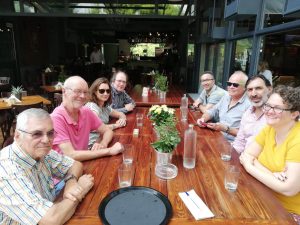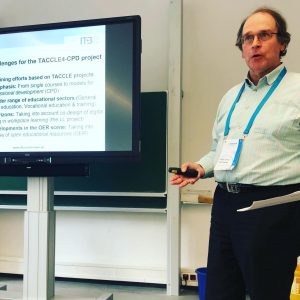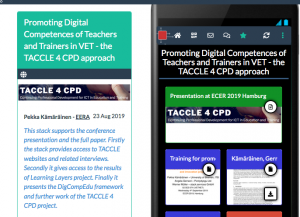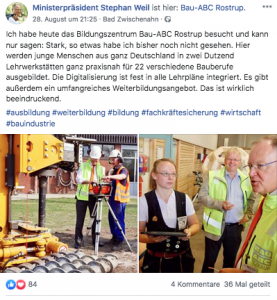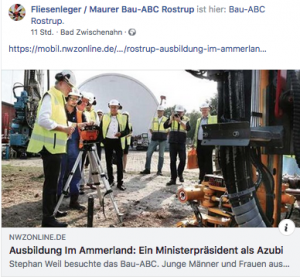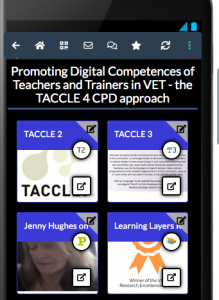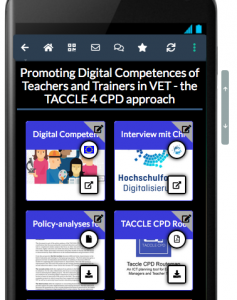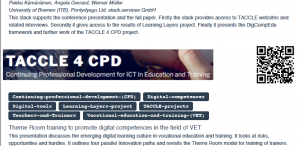Productive project meeting in Athens – Part One: Impressions on the work of the TACCLE VET
Last week I had the chance to participate as a special guest in the project meeting of the TACCLE VET project. This neighbouring project focuses on the prospects for promoting digital competences in different domains of vocational education and training (VET). I am working in the parallel project TACCLE 4 CPD with the task to develop models of continuing professional development (CPD) for the field of VET. At this phase of work we found it important to share knowledge with each other and find ways to work together (instead of duplicating each others’ work). So, I attended the two-day meeting in Athens to learn more of the work of the colleagues and to report of my interim results. We had a very productive meeting that merits to be covered with several blog posts. In this first post I give an overall impression on the work in the TACCLE VET meeting. Below, I give – from a guest perspective – a nutshell description of some of the themes that were discussed in the productive and creative meeting. (See below the picture that was taken at the end of the meeting.)
Interviews with practitioners in different VET domains
The project partners had already completed their interviews with VET practitioners in different domains. Jorge Lizandra presented the general picture in the light of the interview results. In this context it was important that the project focused on enhancing the digital competences in different aspects of teachers’ work – contexts, resources, pedagogy and assessment. Here, the partners paid attention to their common approach to visualising the results in such a way that different domains and country-specific VET cultures can be compared. Also, the partners paid attention to the fact that the use of digital tools in assessment was underdeveloped. In this context there was some discussion, how the proficiency statements of the DigCompEdu framework can be used as a basis for assessment tools. (This issue will be discussed also in the next post.)
My report on interim results in the TACCLE 4 CPD project
In my report on the neighbouring project TACCLE 4 CPD I informed of the policy analyses, on the research paper for the ECER 2019 project, on the emerging ‘Theme Room training” handbook and on the Routemap for planning the training of teachers and trainers. Concerning the policy analyses, we had some discussion on the DigCompEdu framework and its limits vis-à-vis the field of VET. Here, the concepts ‘digital transformation’ (in working life) and ‘digitization’ (in working and learning tasks) played a role. My report on the ECER 2019 conference contributions brought into picture a set of parallel innovation paths in promoting digital competences in VET. Concerning training of trainers, I reported on the piloting with the ‘Theme Room’ training model in the Learning Layers project (in the year 2015) and how this approach is being updated. Concerning the Routemap, I took up the sections for institutional planning of updating/upgrading digital competences and for shaping the corresponding training measures. These aspects were taken up several times when discussing the subsequent points of the agenda. (I will get back to some of these discussions in my next post.)
Plans to shape Learning scenarios, Open Educational Resources and Exemplars of Best Practice
When discussing the subsequent themes,the partners noticed that they can be linked to each other more closely that they had thought originally. The learning scenarios had firstly been thought as more generic and transversal themes. In the light of my presentation the partners concluded that the innovation paths should also provide a basis for scenarios.
In the next phase, the partners concluded that the scenarios can be used as anchor points for presenting a collection of Open Educational Resources (OER) and as Exemplars of good practice. From this point of view the partners drafted a list of potential scenarios – taking into account the interviews in different domains, the propsed transversal themes and the innovation paths that I had presented. (I will get back to some of these discussions in my next post.)
Training of teachers and trainers
Concerning the theme ‘training of teachers and trainers’ we concluded that the TACCLE VET partners have access to different patterns of teacher education, training of trainers and continuing professional development – including online training. From this perspective the partners can provide evaluative feedback. Concerning the TACCLE 4 CPD project, it will provide a ‘handbook’ for training with Theme Rooms and take into account the patterns studied by the TACCLE VET partners.
—
I guess this is enough on the key points and on my impressions on the meeting. The partners have produced more detailed minutes for their internal use. In my next post I will have a closer look at some of the themes and on the collaboration between the two projects in the next phase.
More blogs to come …
